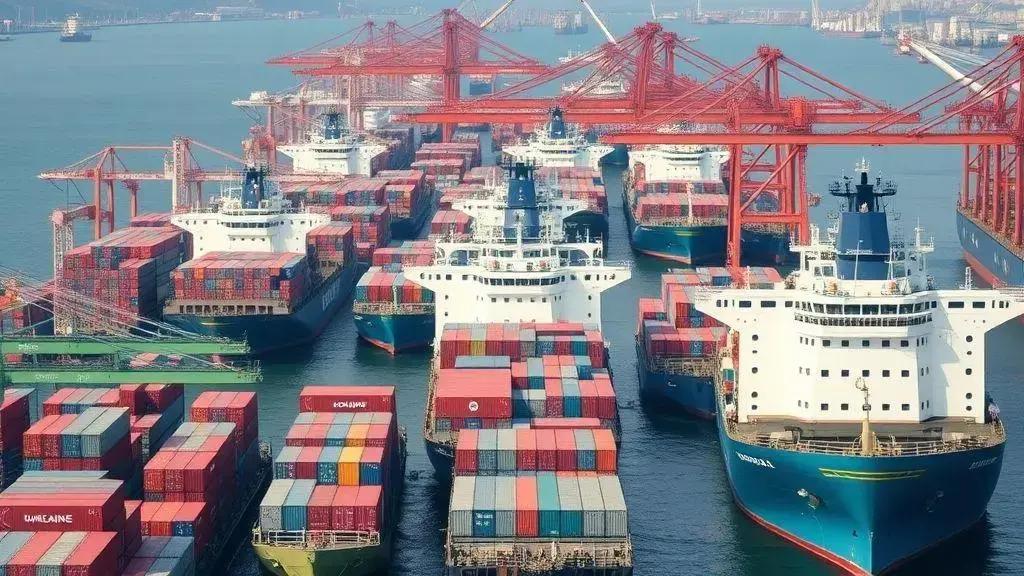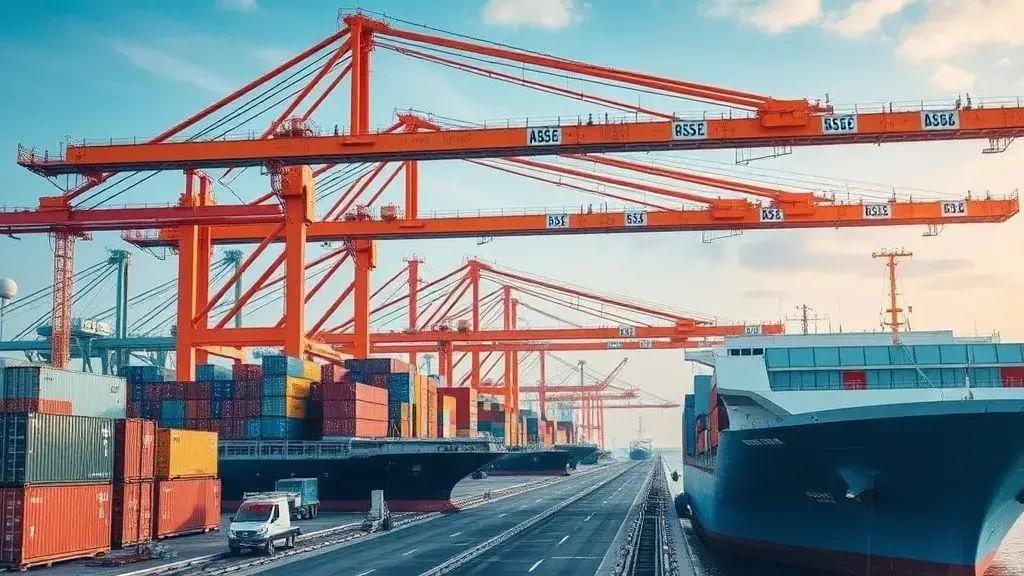Port congestion solutions: overcoming shipping delays

Port congestion solutions involve utilizing smart technologies, automation, and sustainability practices to enhance efficiency, reduce delays, and improve overall logistics in global trade.
Port congestion solutions are becoming increasingly crucial as shipping delays affect businesses worldwide. Have you ever wondered how these bottlenecks impact your delivery times? Let’s dive into effective strategies to navigate this challenge.
Understanding port congestion
Understanding port congestion is crucial for anyone involved in shipping and logistics. This phenomenon affects global trade and can lead to significant delays, impacting businesses and consumers alike.
What causes port congestion? Various factors contribute to this issue. Increased shipping volumes, inadequate infrastructure, and poor planning can all exacerbate congested conditions. As demand for goods rises, ports often struggle to keep up.
Impact of Poor Infrastructure
Poor infrastructure can lead to bottlenecks in the supply chain. If the roads or railways leading to a port are not adequate, this can create a backlog of ships waiting to unload. Such backlogs can result in added costs for shipping companies and longer wait times for consumers.
Increased Shipping Volumes
Another factor is the increase in shipping volumes. Many ports have seen a surge in cargo traffic, especially during peak seasons. This can overwhelm port facilities, leading to delays. As a result, efficient planning and management are essential.
- Investing in technology to improve tracking and communication
- Implementing better scheduling practices
- Enhancing workforce training to improve efficiency
Moreover, weather conditions can also affect port operations. Storms, heavy rains, or fog can lead to temporary shutdowns or slowdowns at ports, increasing congestion. Understanding these external factors is necessary for effective planning and response.
Finally, collaboration among stakeholders is vital. Shipping companies, port authorities, and local governments must work together to overcome the challenges of port congestion. By sharing resources and information, they can develop strategies to mitigate delays and improve overall efficiency.
Impact of congestion on global trade
The impact of congestion on global trade is both vast and complex. As ports become crowded, the flow of goods is directly affected, resulting in delays that ripple through the entire supply chain.
When ports are congested, shipping schedules can be severely disrupted. This means longer waiting times for vessels and increased costs for shipping companies. Every hour a ship spends idling can lead to significant financial losses, not just for the shipping companies, but also for businesses that rely on timely deliveries.
Effects on Businesses
Businesses experience a range of challenges due to congestion. Delays in receiving raw materials can hinder production schedules, leading to missed deadlines. Customers start to feel the effects as products become harder to obtain, resulting in lower satisfaction levels.
- Increased logistics costs
- Higher prices for consumers
- Loss of competitive advantage
Moreover, when port congestion persists, it can lead to long-term contracts being reevaluated. Companies may look for alternative ports or shipping routes to avoid future disruptions. This shift can change long-standing trade relationships and affect global supply networks significantly.
Another area affected is inventory management. Companies often have to hold larger amounts of stock in anticipation of delays. This can tie up a significant amount of capital that could be used elsewhere in the business. Ultimately, understanding these impacts helps companies better prepare for the challenges that arise with port congestion.
Furthermore, the knock-on effects of congestion extend to international relations. Trade disputes may arise if countries perceive that delays are harming their economy. Addressing these issues should be a priority for all nations involved in global trade.
Innovative solutions for reducing delays

Innovative solutions for reducing delays caused by port congestion are essential for maintaining a smooth flow of global trade. By employing new technologies and methods, ports can significantly increase their efficiency.
One effective strategy involves using advanced tracking systems. These systems provide real-time data about cargo movement, allowing companies to plan better and manage resources more effectively. This technology not only improves visibility but also reduces unexpected delays.
Automation in Operations
Automation is another area where ports can make strides. By using automated cranes and vehicles, ports can unload and load cargo faster. This helps to speed up the overall process, reducing the backlog of ships waiting to dock.
- Minimizes human error
- Increases operational speed
- Reduces labor costs
Moreover, enhancing intermodal connections can play a significant role in alleviating congestion. Ports that efficiently link shipping with other transportation methods, like rail and truck services, can move goods faster. For example, efficient rail connections can whisk containers away from the port, decreasing idle time.
Another innovative solution lies in predictive analytics. Analyzing past data can help forecast busy periods and potential congestion, allowing port authorities to prepare in advance. This proactive approach can mitigate delays effectively.
Finally, collaboration among stakeholders is vital in developing effective solutions. When shipping companies, port operators, and local government work together, they can streamline processes. Such cooperative efforts may include shared logistics platforms, which enhance communication and coordination.
Case studies of successful interventions
Case studies of successful interventions in port congestion provide valuable insights into effective strategies that have improved logistics worldwide. By examining real-life examples, we can learn what works and how to apply these solutions in different contexts.
One noteworthy case is the Port of Long Beach in California. This port faced significant congestion due to increasing cargo volumes. To combat this, they implemented a fast track program that streamlined the inspection process for certain high-volume shipments. As a result, the port saw a reduction in clearance times and managed to keep cargo moving efficiently.
Another Example: The Port of Rotterdam
In Europe, the Port of Rotterdam used technology to address congestion issues. They introduced an online platform where shipping companies can manage bookings and track the status of their shipments in real time. This innovation not only improved communication but also helped to optimize the flow of containers through the port.
- Enhanced scheduling capabilities
- Reduced idle times for trucks
- Better resource allocation
In Asia, the Port of Singapore also faced challenges due to rising traffic. Their solution involved investing in automated systems for container handling. By utilizing automated cranes and vehicles, they increased the speed and efficiency of loading and unloading. This move significantly decreased turnaround times for vessels, improving overall port productivity.
Furthermore, collaboration among different stakeholders in these ports led to better problem solving. Regular meetings between port authorities, shipping lines, and logistics companies fostered a spirit of cooperation. Such collaboration often results in shared investments in infrastructure that benefits everyone involved.
Future trends in port management
Future trends in port management are shaping the way global trade will function in the coming years. As technology continues to evolve, ports are adapting to remain competitive and efficient.
One significant trend is the increasing use of smart technologies. This includes the integration of the Internet of Things (IoT) to monitor real-time data about shipping and logistics. By utilizing IoT devices, ports can enhance operational efficiency, reduce waiting times, and improve safety measures.
Sustainable Practices
Another important trend focuses on sustainability. Ports are now looking into eco-friendly operations to reduce their environmental footprint. This shift includes investing in renewable energy sources, such as solar and wind power. Implementing these technologies can help ports minimize emissions and contribute to a greener global economy.
- Adoption of electric cargo handling equipment
- Implementation of waste reduction strategies
- Promotion of eco-friendly shipping practices
Additionally, the rise of automated processes is transforming how ports operate. With advancements in automation technology, many ports are deploying autonomous vehicles and automated stacking cranes to streamline cargo handling. This technology not only speeds up operations but also minimizes human error.
Moreover, enhanced data analytics is becoming a staple in port management. By analyzing cargo patterns and operational data, ports can better forecast demand and optimize their resources. Predictive analytics allows for smarter decision-making, ensuring that ports can handle fluctuations in traffic without becoming congested.
The collaboration between ports and technology companies is also expected to grow. Such partnerships can lead to innovative solutions that address key challenges in logistics and enhance overall productivity.
In conclusion, addressing port congestion requires a multifaceted approach involving innovative solutions, effective management, and collaboration among stakeholders. By learning from successful case studies and embracing future trends like automation and sustainability, ports can enhance their efficiency and resilience. As global trade continues to evolve, staying ahead of these trends is essential for minimizing delays and improving overall supply chain performance.
FAQ – Frequently Asked Questions about Port Congestion Solutions
What are the main causes of port congestion?
Major causes include increased shipping volumes, inadequate infrastructure, and poor planning, which lead to delays and bottlenecks.
How can technology help reduce port congestion?
Technologies like IoT, automation, and data analytics can improve efficiency and tracking, minimizing waiting times and optimizing operations.
What role does sustainability play in port management?
Sustainability initiatives, such as renewable energy and eco-friendly practices, help to reduce environmental impact and can enhance operational efficiency.
Why is collaboration among stakeholders important?
Collaboration allows for shared resources and information, leading to better problem-solving and more effective solutions for congestion issues.





